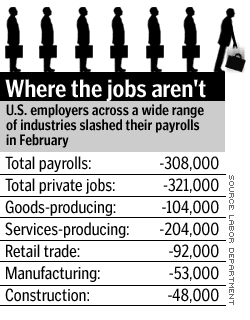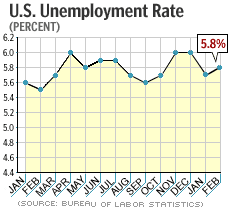NEW YORK (CNN/Money) -
U.S. employers slashed 308,000 jobs in February, the government said Friday, the worst round of job-cutting in 15 months, as the world's biggest economy nearly ground to a halt ahead of a possible war with Iraq.
The report puts added pressure on U.S. policy-makers to help, and some economists think it raises the chance that an interest-rate cut by the Federal Reserve could come as soon as this month.
| Joblessness on the rise
|

|
|
|
|
"What worries me the most is a slip backward becoming a spiral downward. Jobs are the linchpin of both consumer confidence and consumer spending. We can't sustain many more losses like this without that downward spiral getting started," said Bill Cheney, chief economist at John Hancock Financial Services. "This is the kind of data that could make the Fed think about easing again."
Unemployment rose to 5.8 percent from 5.7 percent in January, the Labor Department reported. Non-farm payrolls fell after adding a revised 185,000 jobs in January. It was the biggest drop in payrolls since a loss of 327,000 in November 2001.
Economists, on average, expected unemployment to rise to 5.9 percent and 8,000 new payroll jobs, according to a Reuters poll.
"Since the end of January, things seem to have hit a wall across a wide array of economic indicators," said David Resler, chief economist at Nomura Securities. "This confirms what all that anecdotal evidence and factual reports have been telling us."

The report also raises the chance that the Fed could cut its target for short-term interest rates to make borrowing cheaper and pump more money into the economy at its next policy meeting, scheduled for March 18.
Most economists have long doubted that the Fed would cut rates so soon, thinking Fed Chairman Alan Greenspan would prefer to wait for the situation in Iraq to be resolved, which might help policy-makers gain a clearer understanding of the economy's health.
But Friday's report is a clear sign that, regardless of the war's future impact on the economy, grim things are happening right now, which some economists think might need to be addressed sooner than the Fed would have wanted.
"The Fed cut rates back in November as a growth insurance policy, and here we are, four months later, and employment is still declining," ABN Amro economist Steve Ricchiuto told CNNfn's Market Call program. "This is an important statement to makers of monetary policy -- you need to come in here and do something to get an extra insurance policy."
| 
| |

| 
| 
|

|
 CNNfn's Louise Schiavone reports on February unemployment numbers, up to 5.8 percent from 5.7 percent in January, and the reduction of 308,000 jobs from payrolls. CNNfn's Louise Schiavone reports on February unemployment numbers, up to 5.8 percent from 5.7 percent in January, and the reduction of 308,000 jobs from payrolls.
|
|
Play video
(QuickTime, Real or Windows Media)
|
| 
|

|
|
Late Friday, Merrill Lynch became the first of the "primary dealers," firms that deal directly with the Fed, to predict a rate cut at the Fed's next meeting.
And financial markets were increasingly signaling traders' belief that a cut could be on the way. The federal funds futures contract for March was pricing in a 33 percent chance of a rate cut, and the yield on two-year Treasury notes had fallen below 1.4 percent, a record low.
The past few times the two-year yield has fallen to the Fed's target for its key interest rate, which is now 1.25 percent, the Fed has cut rates.
But with the Fed's key interest rate already at a 40-year low, there's not much room left to cut. The Fed might want to hold as much ammo as it can in case of another shock to the economy. And with interest rates throughout the economy already at rock bottom, how much more easy credit do consumers need?
As an alternative, some economists are calling for help from fiscal policy. Labor Secretary Elaine Chao cited the report as a reason for Congress to pass President Bush's $1.3 trillion package of tax cuts and spending programs, which he has touted as a way to stimulate the economy.
"We hope that the Congress will act speedily," Chao told Market Call.
Congressional Democrats have proposed their own economic stimulus package, which is much smaller but is designed to put money directly into the economy in the short term. President Bush's program is designed more to stimulate activity years in the future.
The report helped sink U.S. stock prices, which bounced back on a report that some of Osama bin Laden's sons had been arrested. Treasury bond prices rose but were well off their early highs.
Longest slump since WWII continues
Friday's report means the 12-month net change in private payrolls has been negative for 20 straight months, extending the longest stretch of labor-market pain since 1944-46. Private payrolls are now 2.5 million jobs lower than they were in March 2001, when a recession began.

U.S. employers cut about 1.8 million jobs from payrolls during the recession, which some economists say ended near the beginning of 2002.
The labor market showed some signs of recovering last summer, but concerns about the possibility of a U.S.-led war in Iraq, a profit-pinching rise in oil and commodity prices, lingering stock-market weakness and other woes forced businesses to further tighten their belts, and job cuts picked up again in the fall and winter.
There are currently 8.45 million unemployed people in the United States, with another 74,000 not counted in the labor force, which includes all the people who've quit looking for work.
The average length of unemployment has risen as well, to 18.6 weeks, the highest in more than eight years. The percentage of people unemployed for 27 weeks or more rose to 22.1 percent, the highest in more than 10 years.
A flood of recent data had prepared many economists for the possibility that Friday's report would be bad news, including a survey of consumers that found jobs were harder to find than any time in nine years, a survey of employers that found hiring intentions were falling and a rise in corporate layoff announcements.
What's more, the four-week moving average of new weekly claims for unemployment benefits is above 400,000, a level that usually indicates a labor market in decline.
The call-up of about 90,000 military reservists in advance of a possible war also sapped untold thousands of jobs from the payroll report; the Labor Department requires that employers exclude called-up reservists when tallying payrolls, but some employers don't comply.
Seasonal factors and bad weather in parts of the country also played a part in the payrolls data, but economists were quick to point out that the magnitude of the ugliness in the payroll report could not be ignored.
"The overall weakness was so pervasive that it would be silly to completely dismiss the devastating weakness of this report," said Anthony Chan, chief economist at Banc One Investment Advisors, who had predicted a drop of 50,000 jobs -- which had been one of the most pessimistic predictions among the 27 economists polled this week by Reuters.
Disconnect between jobless rate, payroll number
Though it might seem unusual that the unemployment rate's gain would be so small on the heels of such an enormous loss in payrolls, the two numbers are generated by different surveys and often give conflicting signals.
What's more, for the second month in a row, the Labor Department changed its statistical methods in the "household survey," which generates the unemployment rate. The department said February's statistics from the household data were not comparable to January's numbers, just as January's numbers were not comparable to December's.
The "establishment report," which generates the payrolls figure, has not been altered so much, and its trend likely paints a more coherent picture of the labor market.
"The payroll survey is the best measure of the absolute amount of employment and employment trends, and this is really quite a pessimistic report," Lawrence Mishel, labor economist at the Economic Policy Institute, told CNNfn's CNNmoney Morning program.
Surprisingly, average wages, a closely watched component of the establishment survey, rose 0.7 percent to $15.08 an hour from $14.97 in January, the biggest gain since 1987.
Economists, on average, expected a gain of 0.3 percent, according to Briefing.com. In a weak labor market, wage growth is a critical support to consumer spending, which makes up more than two-thirds of the nation's economy.
The average workweek for non-supervisory employees fell to 34.1 hours from a revised 34.3 in January. Manufacturing hours were flat, while overtime hours edged higher.
Jobs were cut from a wide range of industries. Payrolls in goods-producing industries fell 104,000, while service-producing jobs fell 204,000.

|

